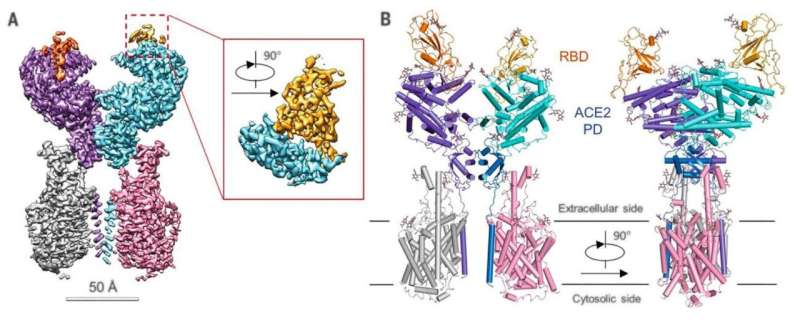Published structure of Spike protein ACE-2 complex. Overall structure of the RBD-ACE2-B0AT1 complex. (A) Cryo-EM map of the RBD-ACE2-B0AT1 complex. (B) The overall structure of the RBD-ACE2-B0AT1 complex. The figure is taken from Yan et al. (2020). Credit: Food & Function (2022). DOI: 10.1039/D2FO00394E
Could consuming a cup of coffee be an effective way to protect yourself against infection with coronavirus? What has not yet been proven in practice is at least very plausible according to biochemical research.
The team led by chemist Professor Nikolai Kuhnert, including Dorothea Schmidt and Nicholas Ohl of Jacobs University, was able to show experimentally—in the laboratory—that the chemical compound 5-caffeoylquinic acid (trivial name: chlorogenic acid), which is found in coffee, inhibits the interaction by a factor of 50 between the SARS CoV-2 spike protein of the coronavirus and the ACE-2 receptor, the docking site for the virus on the human cell.
A regular cup of filter coffee—in the laboratory setting, it comprises exactly 200 milliliters—contains about 100 milligrams of 5-caffeoylquinic acid. Experiments in the laboratory showed that 5-caffeoylquinic acid in this concentration is high enough to prevent the docking of the spike protein to the ACE-2 receptor—and therefore also inhibit the infection process. To prove that this process works in practice as well, further research is required.
It will also take further studies to determine how long the inhibitory effect of 5-caffeoylquinic acid would last. "As chemists, we cannot answer the practical question of whether drinking coffee could really serve as a preventive measure to protect against infection. But we can say it is plausible," said Kuhnert. "Many people drink coffee, and that it has many other positive effects is well established," says the chemist. Regular coffee drinkers suffer less frequently from type II diabetes, for example, he points out.
For their studies on the effect of 5-caffeoylquinic acid on the spike protein and ACE-2 receptor, the team led by Nikolai Kuhnert had to develop a new measurement technique: Differential scanning fluorimetry or nano-DSF. The team recently published a detailed description of this method in the journal Food & Function.
As a next step, the findings on the interaction between coffee and the coronavirus will now be communicated to a wider research community. "Epidemiological studies could determine whether regular coffee drinkers become more often infected with corona or not," says Nikolai Kuhnert. Context and implications for long COVID could also be brought into view here.
More information: Dorothea Schmidt et al, Investigating the interaction between dietary polyphenols, the SARS CoV-2 spike protein and the ACE-2 receptor, Food & Function (2022). DOI: 10.1039/D2FO00394E
Provided by Jacobs University Bremen gGmbH























